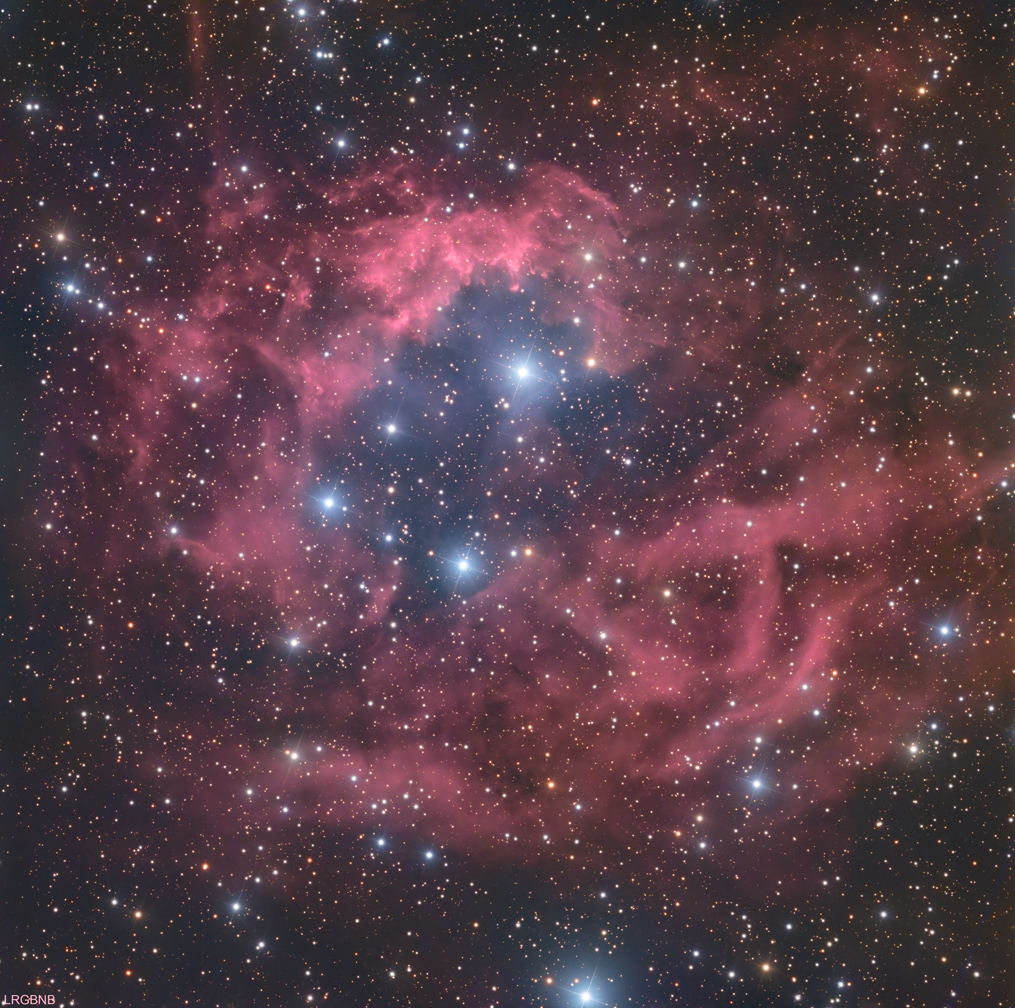HOME
Sh2-261
Sh2-261
Lower's Nebula
Emission Nebula in Orion
Click here for higher-resolution versions: 40% (1624x1612) 65%
(2640x2620) 100% (4061x4031)
 Click on image to cycle through the five versions of the image (described below and labeled on the lower left corner of each image)
Click on image to cycle through the five versions of the image (described below and labeled on the lower left corner of each image)
Sh2-261: This is an emission nebula, a cloud of hydrogen gas in which stars are being formed; the energetic,
young stars in the nebula ionize the hydrogen, which causes the characteristic red color of the nebula. Sulfur and oxygen atoms also are being ionized (others, too, I suspect, but they don't
noticeably affect the color of the nebula as we see it). Perhaps the star causing the most ionization is HD 41997, the bright blue star at the top edge of the triangular blue nebula just
above the center of the image. This type of star called a "runaway" since it has motion relative to what's around it of greater than 40 km/s.
The nebula is thought to be about 3,000 light years from Earth. At that distance, the bulk of the nebula is roughly 33 by 25 light years in dimension.
I have presented this in six different formats (each image is labeled in the lower left corner); this is the order in which they appear as you cycle through (by repeatedly clicking on the photo,
waiting for each to download):
(i) A version (the top photo in the stack, labeled "LRGBNB" in the lower left corner), with the color created by imaging through red, green and blue filters (with a significant
amount of Ha and OIII data blended in to both the color layer and the luminance layer); the effect of weaving the Ha and OIII data into the broadband data (L, R, G and B) is to enhance the red emissions
from the Ha and blue/green emissions from the OIII;
(ii) A bi-color version (almost true-color version, labeled "HOO"; the second photo in the stack), in which "red" is ionized hydrogen emissions (Ha),
and green and blue are doubly-ionized oxygen emissions (OIII); this works (giving fairly accurate colors) in this nebula because the vast majority of the emissions are in Ha, OIII and SII, and Ha and SII
both are in the red part of the spectrum, while OIII is blue-green;
(iii) A true-color version (labeled "LRGB"), with the color created by imaging through red, green and blue filters, and the luminance (detail) layer created by imaging only
through a clear filter (with no narrow band data included in either the luminance layer or the color layer);
(iv) A version in the Hubble palette (a lot of the Hubble photos, including and especially the famous "Pillars of Creation," are made with this set of filters, since
it's a useful set for scientists to see what's actually happening), which shows SII emissions as red, Ha emissions as green, and OIII as blue. Because emission nebulae so often are overwhelmingly
made up of Ha emissions, this would be as green as the "true color" versions are red; so I have (i) de-emphasize the Ha emissions, and (iii) boosted the sulfur and oxygen emissions;
(v) A version in the Hubble palette, but I have neutralized the green to a tan color;
(vi) A grayscale image, which is a composite of the Ha data and the SII data; unusually, there is quite a bit of SII data, and relatively little OIII data in this nebula.
The top version shows approximately the colors of the object; the "almost true-color" (HOO) version is shown because it is a short-cut way to get a pretty picture, without taking so much time gathering
data from 7 filters, so is very popular with astrophotographers (especially in light-polluted areas, because the narrow-band filters filter out the effects of most light pollution), and it shows
the dominant emissions--Ha as red and OIII as blue-green--quite graphically in one frame, though I'm not a fan of the blue/green stars or the tint of the red nebula; the LRGB version has no data
taken through a narrow-band filter included, and the difference from the LRGBNB version (the top one in the stack) is remarkable (seeming to mix the red and blue into a purple in a lot of the nebula;
the Hubble palette is just because Hubble does it that way, and it's interesting to add the sulfur emissions; and the grayscale Ha/SII is interesting just because it's pretty.
Technical Information:
Ha:OIII:SII:L:R:G:B: 690:600:690:570:300:210:280 (a total of almost 56 hours of light-frame exposure time); luminance exposures were a mix of 3-minute and 15-minute exposures;
Red were 15-minute exposures; green were all 15-minute exposures; blue all 20-minute exposures; Ha, SII and OIII were all 30-minute exposures. In the LRGBNB version, the Ha data were blended into the
luminance layer; the Ha data also were blended into the red channel, while the OIII data were blended into both the green and blue channels.
Equipment: RC Optical Systems 14.5 inch Ritchey-Chretien carbon fiber truss telescope, with ion-milled optics and RCOS field flattener, at about f/9, and an SBIG STX-16803 camera with
internal filter wheel (SBIG filter set), guided by an SBIG AO-X, all riding on a Bisque Paramount ME German Equatorial Mount.
Image Acquisition/Camera Control: Maxim DL, controlled with ACP Expert/Scheduler, working in concert with TheSky X.
Processing: All images calibrated (darks, bias and sky flats), aligned, combined and cropped in Pixinsight. Color combine in Pixinsight. Some finish work (background neutralization,
color calibration, Noise XTerminator, Blur XTerminator, ) done in Pixinsight; some cleanup finish work was done in Photoshop CC.
Location: Data acquired remotely from Sierra Remote Obseratories, Auberry, California, USA.
Date: Images taken on many nights in during the winter of 2023-2024 and the winter of 2024-2025; image posted April 13, 2025.
Date: Image scale of full-resolution image: 0.56 arcseconds per pixel.
CCD Chip temperature: -25C
Copyright 2023, 2024, 2025 Mark de Regt
